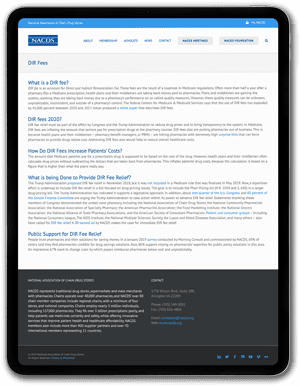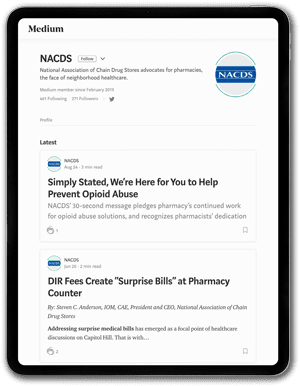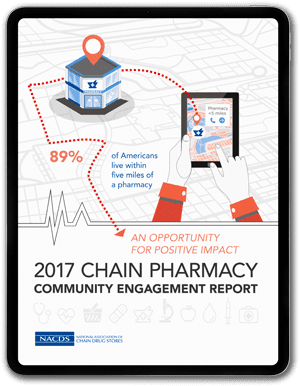HELPING TO SOLVE THE OPIOID ABUSE EPIDEMIC
In the community…
By a 2-to-1 margin, pharmacies and pharmacists are considered more as part of the solution than as part of the problem of opioid abuse.
In policy…
Support leveraging pharmacies’ role to help solve issues related to opioid abuse.
National poll of 1,995 registered voters, conducted January 4-6, 2019, by Morning Consult and commissioned by NACDS (margin of error +/- 2%).
In the community…
By a 2-to-1 margin, pharmacies and pharmacists are considered more as part of the solution than as part of the problem of opioid abuse.
In policy…
Support leveraging pharmacies’ role to help solve issues related to opioid abuse.
National poll of 1,995 registered voters, conducted January 4-6, 2019, by Morning Consult and commissioned by NACDS (margin of error +/- 2%).
NACDS’ Public Policy Recommendations
Legislate a 7-day supply limit for initial opioid prescriptions issued for acute, or temporary, pain
- NACDS backs federal legislation that – consistent with the Centers for Disease Control and Prevention Guideline for Prescribing Opioids for Chronic Pain – would limit the supply of a patient’s first opioid prescription to seven days, when that prescription is for acute pain such as that caused by an injury.
- This type of policy would in no way limit a prescriber’s ability to prescribe alternative pain-management therapies. Nor would such a policy in limit the treatment of chronic, or ongoing, pain, or of pain related to cancer, illness, or end-of-life – an essential point that must be emphasized.
- CDC clinical evidence shows that a greater amount of initial opioid exposure is associated with greater risk for long-term use and addiction.
- Nearly 2/3 of states already have taken action; federal legislation is needed for consistent patient care.
Legislate a requirement that all prescriptions be issued electronically, with limited exceptions
- E-prescribing enhances security and curbs fraud, waste and abuse; and Drug Enforcement Administration (DEA) e-prescribing requirements call for two-factor authentication, reducing the likelihood of fraudulent prescribing.
- In an important victory, the SUPPORT for Patients and Communities Act, enacted in 2018, requires e-prescribing of controlled substances under Medicare Part D. Approximately half of the states also have enacted an NACDS-backed e-prescribing requirement, further enhancing the use of e-prescribing to prevent fraud, waste and abuse.
- Action is timely, as e-prescribing of controlled substances has only been legal in all 50 states since September 2015.
- Only 38 percent of controlled substance prescriptions are issued electronically.
Create a nationwide prescription drug monitoring program (PDMP) through collaboration, while concurrently improving PDMPs to foster the goal of a nationwide database
- Most states use data to help identify and prevent drug abuse and diversion, but program variances limit their effectiveness.
- It is necessary to harmonize state requirements for reporting and accessing PDMP data, and to create a nationwide system with unified expectations by healthcare providers and law enforcement.
- A nationwide PDMP would leverage e-prescribing to provide guidance for prescribers and dispensers in real-time when providing patient care.
- Additional reforms will be pursued concurrently with NACDS’ nationwide PDMP database policy, including daily reporting of controlled substance dispensing information to state PDMPs; data standardization to improve PDMP usefulness; prescribers checking state PDMP prior to issuing a controlled substance prescription; and enabling interstate access to PDMP data.
Enable pharmacies to provide prescription disposal solutions that meet patients’ needs
- Currently, many pharmacies offer disposal programs as appropriate by community and by store.
- Flexible disposal programs wherein pharmacies elect to provide consumers with at least one of the several Drug Enforcement Administration-authorized options for drug disposal is universally workable.
- Educational materials also are in use, and could be expanded in appropriate ways.
Reforms in health-plan design to help identify and treat substance abuse disorders
- NACDS will pursue federal and/or state policies that facilitate early interventions and mandate coverage for substance use disorder (SUD) treatment programs for opioids, heroin, cocaine, et. al.
- Opportunities exist to leverage the role of the pharmacist in services that improve access to medications for SUDs and addiction, and incentivize screenings for SUDs and improve access to medication assisted treatment (MAT) at the physician and community pharmacy levels.
- Pharmacists should be empowered for duties associated with the identification and treatment of SUDs.
- It is important to enhance the training of case workers, behavioral counselors, and pharmacy technicians regarding SUDs and overdose.
Improved coverage for pain-management treatments other than opioids
- We need to reverse the dynamic through which chronic pain patients are prescribed an opioid because alternative therapies (pharmacologic and/or other complementary or integrated health services) are not preferred, are less affordable, or are not covered.
- NACDS proposes to pursue federal and/or state policies policies that require coverage of alternative, non-opioid drug therapies for chronic pain management at the same formulary and cost-sharing tier.
- NACDS proposes to require coverage of complementary or integrated health pain management services.
Enabling patient access to naloxone – the overdose antidote – when opioids are prescribed
- As certain patient populations are at increased risk of overdose due to the nature of their condition or the combination of medications they are required to take, co-prescribing of naloxone ensures immediate access to overdose prevention medication that could prove life-saving in emergencies.
- NACDS will pursue state legislation that ensures all patients taking potentially dangerous combinations have access to naloxone when the initial opioid prescription is filled.
- NACDS urges authorizing pharmacists to prescribe and dispense naloxone immediately upon identifying patients at potential risk of overdose, or an individual that presents with possible abuse of heroin.
Every day, pharmacists face a moment of truth. When presented with an opioid prescription, a pharmacist must make decisions as a provider of patient care, and as part of the drug-abuse solution. Based on these experiences, NACDS has announced recommendations on this complex issue, to complement pharmacy’s ongoing collaboration with other healthcare professionals and with law enforcement.
These public policy concepts complement pharmacy’s existing and extensive collaborative efforts, including: compliance programs; pioneering e-prescribing; drug disposal; patient education; security initiatives; fostering naloxone access; stopping illegal online drug-sellers and rogue clinics; and more.



